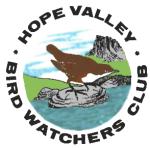
HOPE VALLEY BIRD WATCHERS CLUB

Despite the snow and bitterly cold north-easterly wind about 55 species were seen, including: fieldfare, redwing, redpoll, siskin, willow tit, tree sparrow, goldeneye, raven, barnacle goose. The star birds, however, were the red-crested pochard, which were finally located in the marina.
Over 50 species were encountered but there was nothing greatly exciting on the lake or in the woods. This changed on Cabinhill, after the ford, for in the field, which was being ploughed, were several foraging woodlark and they gave some of the best views ever of this lark.
The day started off cool and misty, but was soon replaced with glorious sunshine. The wildfowl were well represented and among the 20 or so species were goldeneye, goosander, smew, and a solitary bar-headed goose. There was also a large mixed flock of siskin, redpoll and goldcrest foraging in the trees. Number of species totalled 56.
Old Moor Wetlands has quite literally risen from the ashes and the diversity of avifauna that it attracts goes from strength to strength. Tree sparrows and yellowhammers are doing well, particularly as winter feeding is now concentrating more on finches and buntings. Thousands of golden plover and lapwing added to the spectacle, though a fleeting glimpse of kingfisher, and summer arrivals of chiffchaff and sand martin were perhaps as memorable. Nearly 60 species were recorded.
The mists of this warm spring day gave way to sunshine. The usual coffee break
by Howden Dam was accompanied by the spectacular appearance of a Goshawk, otherwise
the birds were disobliging.
A detour to Shillito Wood provided good views of a roosting long-eared owl.
A good day's birding in glorious sunshine provided many with their first good
sightings of some summer migrants: chiffchaff, willow warbler, blackcap, whitethroat,
sand martin, and swallow.
Just under 50 species were recorded, but nobody was disappointed, though the lesser scaup proved elusive.
Who in their right mind would be at Clumber Park at 7-o'clock in the morning? Anyone that wanted to record 77 species, though the day was not just about quantity, but quality and included: redpoll, treecreeper, yellowhammer, tree pipit, buzzard, yellow wagtail, whinchat, grey partridge, woodlark, crossbill, mandarin, garden warbler, and stonechat. We also had spectacular views of a Green Woodpecker by the side of Lake Arm.
Marsh Harrier was among the 60 species that were recorded, as was avocet, which
are probably the two species one expects to see at Blacktoft, and a drake garganey
added to the day's enjoyment. A good selection of other waders were also present,
including: dunlin, ringed plover, little ringed plover, black-tailed godwit,
oystercatcher, curlew, and redshank.
A discussion with the warden revealed how Ruddy Duck vandalise some of the other birds' nests, such as Pochard and Little Grebe. Despite this, public opinion is generally against the culling of the Ruddy Duck.
The din and stench of thousands of birds is surprisingly tolerable when faced
by the awesome spectacle of a seabird colony. The list of observed seabirds
comprised: herring gull, kittiwake, razorbill, gannet, guillemot, puffin, fulmar,
shag, great black-backed gull, and cormorant. A "bridled" guillemot, a variant
with a white eye-ring and stripe, proved to be an attraction.
The return journey included a visit to Blacktoft, and this added extended views of a magnificent singing grasshopper warbler. Other stars among the supporting cast were: barn owl, spoonbill, green sandpiper, spotted redshank, and corn bunting (at Crowle), bringing the day's list to 72 species.
The sunny evening was brought alive by a couple of dazzling kingfishers, which
were fishing and squabbling opposite the boat dock. Prior to this, a pair of
Egyptian geese and a barnacle goose had added variety to the expected sightings
(42 species in total). The evening, however, was about observing nightjars.
The plantation towards Thoresby again provided sightings of "churring" nightjars, albeit not as clear as last year, but two woodcocks and an unidentified owl managed to steal the nightjars' glory and despite the tormenting mosquitoes.
Sadly, a day more likely to be remembered for the millions of annoying, irritating flies than the 40 species seen, which included: avocet, curlew sandpiper, kingfisher, marsh harrier, yellow wagtail, buzzard, and barn owl.
There were not as many species as in the spring, but another great day was assured
with several green sandpiper, common sandpiper, snipe, kingfisher, and garganey.
The black-tailed godwit were feeding immediately in front of the Wath Ings hide
and provided a superb photo-shoot opportunity.
The enduring memory will be of the little grebe that escaped from the juvenile
grey heron that had seized it for its lunch.
The day's total was about 45 species.
This reserve can be expected to produce 70-80 species in a day, and this trip was no different, except that not a single bearded tit was seen or heard. The waders included grey plover, curlew, lapwing, dunlin, curlew sandpiper, ringed plover, avocet, ruff, little egret, oystercatcher, grey heron, spotted redshank, greenshank, redshank, sanderling, turnstone, knot, golden plover, black-tailed godwit, bar-tailed godwit, and, of course, Sammy the black-winged stilt. The wader that stole the show, however, was a wood sandpiper that was feeding just in front of the hides. Excellent views of a water rail, eider, and common scoter were also had. There was even a common buzzard out at sea!